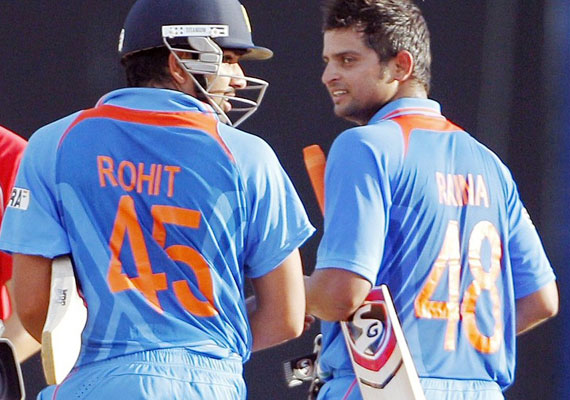 |
| Who fits where? |
- V has been doing well for long at no.5 now and wants to play at no.3 or 4, something he has expressed quite often in media.
- W, who had been promoted from no. 4 to the opener slot sometime back, finds lean patch and gets injured.
- Then X, a good performing no.4 middle order batsman replaces W.
- Y, a regular no.3 batsmen finds long bad form and drops to 4.
- , Z, a new regular in the eleven replaces Y at no.3 after some good shows at no.5.
- Meanwhile, W remarks in the media that he would love to come back to opening position when he comes back from injury.
If you are an Indian cricket fan, you must have figured out this puzzle by now. V is Suresh Raina, W is Rohit Sharma, X is Ajinkya Rahane, Y is Virat Kohli and Z is Ambati Rayudu.
In good times, this seemed like a problem of plenty where a set of in-form middle order batsmen were vying for few slots. Fast forward to the second ODI against West Indies, all this competition now seems a chaos waiting to be solved. Although India managed to level the series at Kotla but the cracks in the batting line-up are apparent.
The Chaos behind the batting order shuffle
In the Greg Chappell Era, this constant
shuffle in the batting order was termed as ‘flexibility’. It was aimed at
making most of the middle order batsmen floaters, so that they could bat in
different situations and face different type of bowlers. The logic seemed
shallow. In the process of adding flexibility, no one knew what their role was.
Was Irfan Pathan a pinchitter or a lower order bat? Was Venugopal Rao a no.3
batsmen for anchoring the innings or a no.6 batsman for exploiting slog overs?
The constant reshuffle in the current
batting order suggests two things:
First, that Dhoni doesn’t want to rope in
new players at this point of time when the World Cup is around the corner. He
knows that he has to back these 7-8 batsmen to get back in form and do well at
one of the batting positions. When Rahane took to opening position like
proverbial fish to water, Dhoni’s enthusiastic comments in media reflected how
much eager he is to solve the batting puzzle from the existing pieces only. He
is right to an extent too. India has less than 10 ODIs before they head to the
World Cup, which means that a new batsmen has no scope of failure.
Second, India needs all the six top order
batsmen to click because they are most likely to play with a combination of ‘ 6
batsmen- Jadeja- 1 spinner- 3 pacers’ in the World Cup. With this combination,
India can’t afford someone to carry lean patch to the tournament. If Dhoni has
made his mind about going with these set of batsmen, he has to ensure they all
find form. And for that, he might try giving everyone a good time in the
middle. This explains Rayudu’s promotion to no. 3 in the Delhi ODI. If Rayudu
fails to string a set of good scores, Rohit Sharma will walk in his place after
returning from injury.
Replacing a knight with a knight
One thing that Dhoni and previous Indian
captains have often tried is that they have replaced a knight with a bishop.
Middle order batsmen have opened in absence of a regular opener. It does make
sense in case of Rahane, who was always an opener in his early domestic career
stage. But it never made sense for Rohit Sharma, who always seemed fit for the
no.4 position. Contrary to this logic, Rohit had a good time with Dhawan in
2013 but eventually he ran out of steam. The lack of a Yuvraj Singh or Virender
Sehwag-a genuine no.5 bowler is hurting Dhoni’s permutations badly. To
trade-off a genuine No. 7 batsman, he tries to play an extra bowler and even
after that, Raina and Kohli have to turn their arms for small spells. The extra
bowler formula has worked for Dhoni in the sense that he feels confident about
bowling out oppositions more often. But, somewhere it has depth the strength of
the batting order. Indian batting has a set of batsmen, all of whom are getting
starts but none of them taking the anchor. This short and inconsistent batting
order means that quick wickets won’t allow Dhoni and Raina to play with more
freedom. The chaos has been partly set because bishops are replacing knights.
The problem with this mess is that it is too late to do overhauls. Maybe a long term planning was needed and more performers in the domestic circuit could have been given chances to set up a strong bench. With that never happening, perhaps shuffling is the best game Dhoni can play and hope that the jigsaw pieces finally find a fit. And that the chaos gets unraveled.